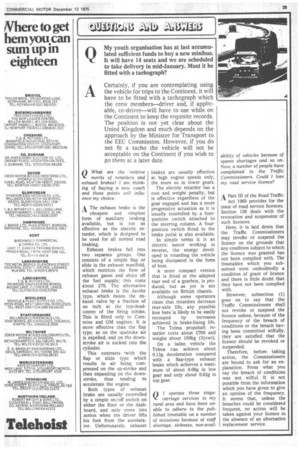Q What are the relative merits of retarders and exhaust brakes?
Page 29

If you've noticed an error in this article please click here to report it so we can fix it.
I am thinking of buying a new coach and these points will influence my choice.
A The exhaust brake is the cheapest and simplest form of auxiliary braking available, but is not as effective as the electric retarder, which is designed to be used for all normal road braking.
Exhaust brakes fall into two separate groups. One consists of a simple flap or slide in the exhaust manifold, which restricts the flow of exhaust gases and shuts off the fuel supply; this costs about £70. The alternative exhaust brake is the Jacobs , type, which raises the exhaust valve by a fraction of an inch at the top-deadcentre of the firing stroke. This is fitted only to Cummins and GM engines. It is more effective than the flap type, as on the upstroke air is expelled, and on the downstroke air is sucked into the cylinder.
This contrasts with the flap or slide type which results :in air being compressed on the up-stroke and then expanding on the downstroke, thus tending to accelerate the engine.
Both types of exhaust brake are usually controlled by a simple on/off switch on either the floor or the dashboard, and only come into action when the driver lifts his foot from the accelerator. Unfortunately, exhaust brakes are usually effective at high engine speeds only, the more so in lower gears.
The electric retarder has a cost and weight penalty, but is effective regardless of the gear engaged and has a more progressive actuation as it is usually controlled by a fourposition switch attached to the steering column. A fourposition switch fitted to the brake pedal is also available.
In simple terms it is an electric motor working in reverse, the energy developed in retarding the vehicle being dissipated in the form of heat.
A more compact version that is fitted at the adapted rear end of a gearbox, is produced, but as yet is not available on British chassis.
Although some operators claim that retarders decrease rear-axle life, any possible loss here is likely to be easily recouped by increases achieved in brake-lining life.
The Telma propshaft retarder costs about £700 and weighs about 150kg (newt).
On a laden vehicle the Telma can achieve about 0.13g deceleration compared with a flap-type exhaust brake which achieves a maximum of about 0.08g in low gear and only about 0.02g in top gear.














































































